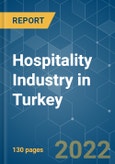The growing number of visitors is making the hospitality industry in Turkey an attractive market for investors. The country registered 40 million visitor arrivals in 2018 and 51.9 million in 2019 which is a rise of 13.7% from the previous year. The tourism industry in Turkey is primarily driven by its rich culture and heritage. The country has set the target to welcome 50 million travelers as a part of Vision 2023 goal and to generate USD 50 billion for the same. In support of this, the Ministry of Culture and Tourism lifted restrictions on seasonal resorts concept in some areas and is allowing them to operate the full year cycle. With this move, the existing resort managements are promoting their respective resorts all year long by turning themselves with the seasons by turning resorts depending upon the seasons. These initiatives helped the country to record growing numbers of average daily revenue (ADR) and revenue per available room (RevPAR). For the year 2018, Turkey registered a 6.5% growth in ADR, a 3.9% increase in RevPAR (3.9%), and the occupancy rate also increased by 2.5%. Turkey has more than 900 hotel chains present in the country that are offering more than 1.7 lakh rooms of different segments/class. There are around 60 brands in the country of which more than 70% are domestic brands. The cities with high number of rooms are Antalya, Istanbul, and Mugla with 883, 745 and 503 hotels respectively.
Key Market Trends
The Mid and Upper Mid-scale Segment Hotels are Occupying a Higher Share of the Total Market
The tourist arrivals to the country are recording a growing number and visitors from foreign countries are on the rise. The statistical data revealed that turkey generated more than USD 1 billion from the hospitality industry. The country has more than 900 hotels that are providing more than 1.7 lakh rooms across the country. The mid and upper mid-scale segment occupied a major share of the market, with more than 500 properties across the country, followed by the luxury segment, with around 320 properties.
To Address the Growing Demand, More Hotels are Going to be Built in Istanbul
According to the Turkish Statistical Institute, Istanbul was the top arriving destination in Turkey for 2019 with nearly 15 million tourist arrivals of which around 33% are from foreign countries followed by Antalya with 14.65 million and Northwestern province of Edirne with around 4.3 million visitors. With these rising numbers of visitors, the country generated USD 34.5 billion tourism revenue in 2019 which is a new record high and is made a 17% increase when compared to USD 29.5 billion it generated in 2018. In order to accommodate this growing number of visitors, more than 1000rooms from different hotel brands are being added and are going to be added to the supply during 2018-2021, in Istanbul.
Competitive Landscape
The industry is largely dominated by domestic brands, whereas the international brands have addressed most of the supply. The region been attracting a great number of investors and has more diversified profiles of such companies. The franchising model is dominating the market.
Additional Benefits:
- The market estimate (ME) sheet in Excel format
- 3 months of analyst support
This product will be delivered within 2 business days.
Table of Contents
Methodology

LOADING...








